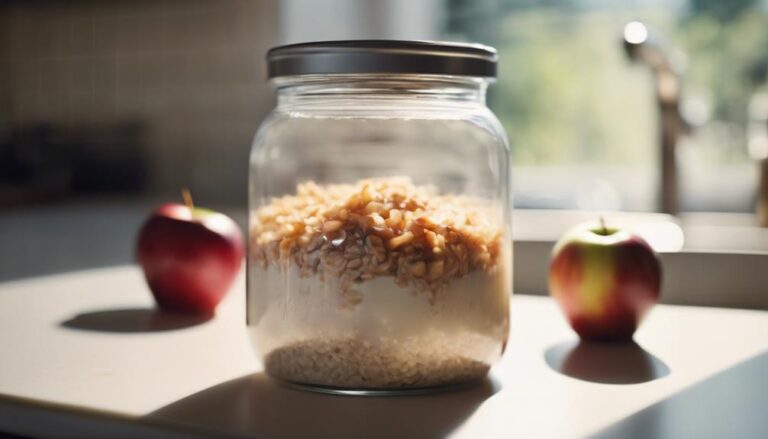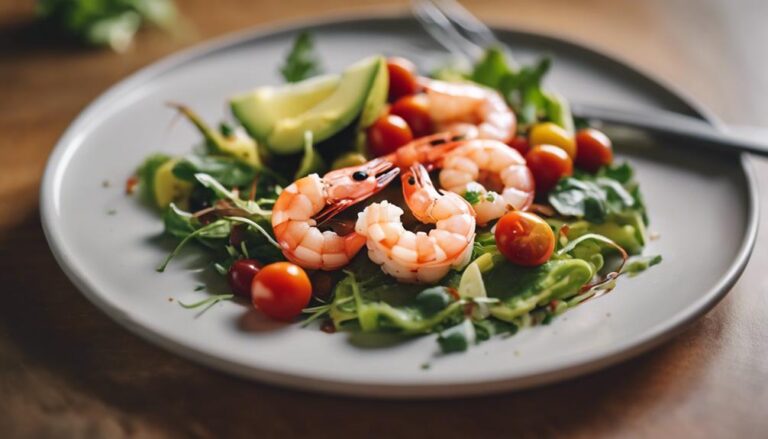Breakfast Boost: Sous Vide Lectin-Free Coconut Yogurt
Enhance your mornings with a nutritious breakfast by making lectin-free coconut yogurt using sous vide. Use precise time and temperature control for the perfect texture. Experiment with flavor combinations like tropical pineapple or citrus zing. Don't forget key components like probiotics for gut health. Strain your yogurt for extra creaminess using cheesecloth or nut milk bags. Remember, every second and degree counts in achieving that creamy, tangy consistency. If you want to discover more about perfecting your lectin-free coconut yogurt, there's a wealth of additional information waiting for you.
What You Will Learn Here
- Sous vide technique ensures precise temperature control for perfect lectin-free coconut yogurt.
- Experiment with straining times for desired creaminess and thickness.
- Customize with flavor variations like tropical pineapple or berry blast.
- Ferment lectin-free coconut yogurt for 8-10 hours for optimal texture.
- Enjoy dairy-free, nutrient-packed breakfast delight with creamy chia seed yogurt.
Yogurt-Making Techniques
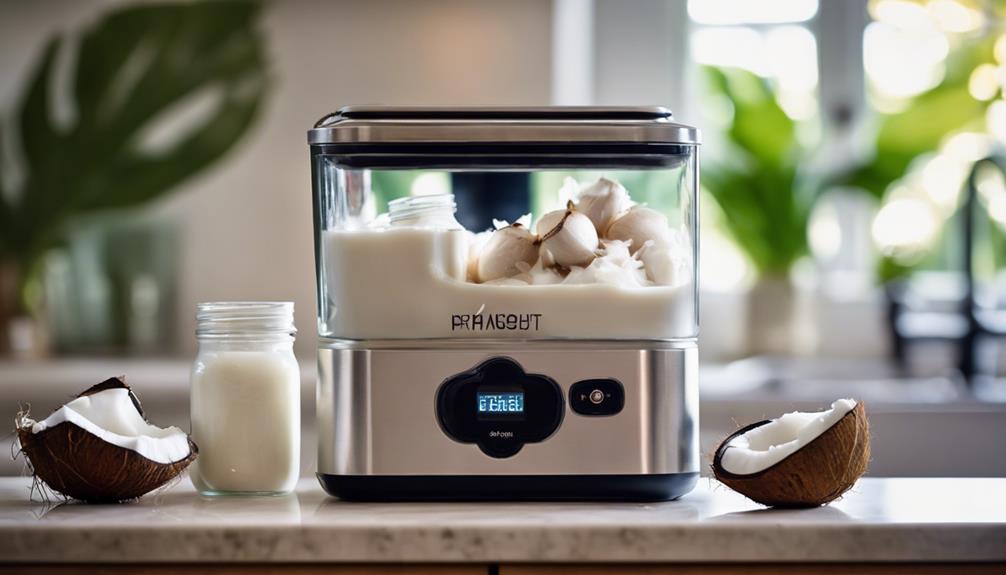
To create high-quality yogurt at home, focus on achieving the desired consistency by adjusting the ingredients and fermentation time.
Pay close attention to the time and temperature during the yogurt-making process to guarantee proper fermentation and texture.
Experiment with different flavoring variations to customize your yogurt to suit your taste preferences.
Yogurt Consistency Tips
Enhance the texture of your coconut yogurt by exploring different straining methods. Achieving the ideal yogurt thickness is crucial to a velvety and luxurious consistency. One of the consistency secrets lies in using a cheesecloth or nut milk bag to strain your coconut yogurt. This process helps remove excess liquid, resulting in a thicker and creamier end product.
Another tip to explore is adjusting the straining time based on your preference for thickness. For a thicker yogurt, allow it to strain for a longer period to achieve a more solid texture. Conversely, if you prefer a slightly runnier consistency, reduce the straining time accordingly.
Additionally, gently stirring the yogurt before straining can also affect its final texture. Experiment with different stirring techniques to find the one that provides the desired consistency.
Time and Temperature
Experiment with varying time and temperature settings to refine your yogurt-making techniques. Utilizing sous vide benefits, such as precise temperature control, guarantees a consistent and creamy yogurt every time. By adjusting the temperature, you can achieve the perfect texture and flavor for your lectin-free coconut yogurt.
When exploring time-saving techniques for breakfast prep, consider how different temperatures can impact the fermentation process. Lower temperatures may require longer incubation times, while higher temperatures can expedite the process. Finding the ideal balance between time and temperature is crucial for efficient yogurt-making.
For a convenient breakfast option, try setting your sous vide machine the night before to have fresh yogurt ready in the morning. This time and temperature strategy allows you to enjoy a nutritious and delicious meal without the hassle of last-minute preparations.
Experiment with different combinations to discover the perfect timing and temperature settings that match your preferences.
Flavoring Variations
Exploring different flavoring variations can elevate the taste profile of your lectin-free coconut yogurt, enhancing your overall yogurt-making experience. When it comes to flavoring inspiration, get creative with pairings to create unique combinations that will delight your taste buds. Experimenting with different tastes can lead to exciting discoveries and help you find the perfect flavor for your yogurt.
Here are some taste experimentation suggestions to inspire your yogurt-making journey:
| Flavor | Ingredients | Pairings |
|---|---|---|
| Tropical Twist | Fresh pineapple chunks | Toasted coconut flakes |
| Berry Blast | Mixed berries | Chia seeds |
| Citrus Zing | Orange zest | Almond slices |
| Spiced Delight | Cinnamon and nutmeg | Granola clusters |
| Minty Freshness | Fresh mint leaves | Dark chocolate chips |
Key Yogurt Components
Yogurt's key components include live cultures, proteins, and fats that contribute to its texture and flavor profile. When consumed, yogurt offers probiotic benefits that support digestive health. For those seeking dairy alternatives, yogurt plays a pivotal role in promoting gut health.
Here are the key components of yogurt:
- Live Cultures: These are the beneficial bacteria that aid in digestion and contribute to the probiotic benefits of yogurt.
- Proteins: Essential for building and repairing tissues in the body, proteins in yogurt provide a satisfying and nourishing element to your diet.
- Fats: While yogurt contains fats, they can vary based on the type of milk used, adding richness and creaminess to the yogurt.
- Nutrients: Yogurt is a good source of various essential nutrients like calcium, potassium, and vitamin D, contributing to overall health and well-being.
Understanding these components can help you appreciate the wholesome goodness that yogurt brings to your breakfast table.
Lectin-Free Coconut Yogurt Recipes
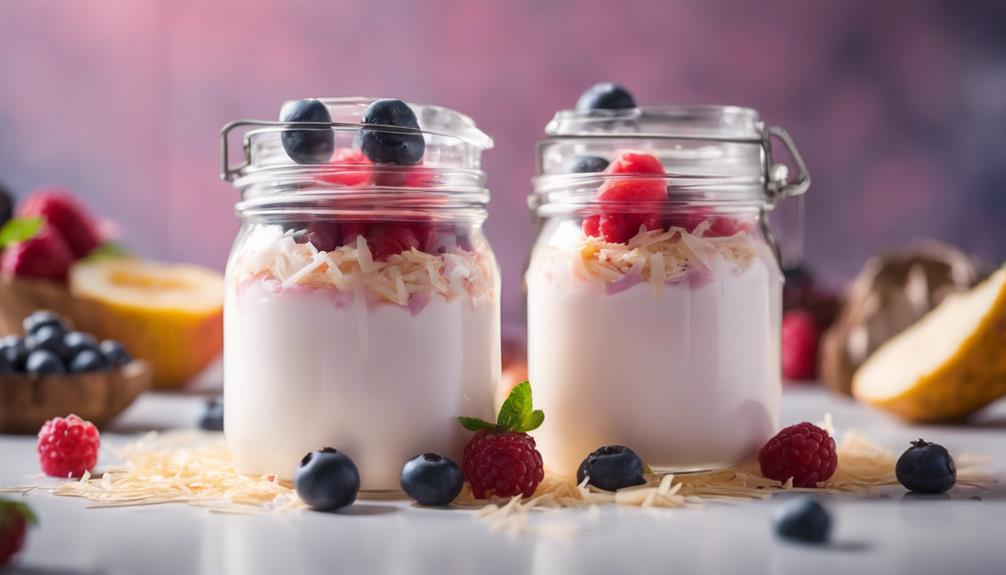
Discover the delicious world of lectin-free coconut yogurt recipes with a variety of tempting options to try.
Start your day with a flavorful breakfast delight, indulge in the creamy goodness of chia seed yogurt, or transport yourself to a tropical paradise with a pineapple yogurt bowl.
These recipes offer a delightful way to enjoy a healthy and flavorful dairy-free yogurt alternative.
Coconut Yogurt Recipe: Breakfast Delight
Indulge in a nutritious and delicious breakfast by trying out this lectin-free coconut yogurt recipe. Making your own coconut yogurt not only guarantees you know exactly what goes into it but also allows you to tailor it to your taste preferences.
Here's a simple recipe to get you started:
- Blend together coconut milk, probiotic capsules, and a natural sweetener like maple syrup or honey.
- Pour the mixture into a glass jar and let it ferment for 24-48 hours to develop those probiotic benefits.
- Chill the yogurt in the refrigerator to thicken before serving.
- Top your coconut yogurt with fresh fruits, nuts, or seeds for added flavor and texture.
This dairy-free alternative not only supports gut health but also provides a creamy and satisfying breakfast option. Experiment with different toppings and enjoy a nutrient-packed start to your day with this homemade coconut yogurt.
Creamy Chia Seed Yogurt
To create a satisfyingly creamy and lectin-free coconut yogurt variation, consider incorporating chia seeds for added texture and nutritional benefits. Chia seeds, a superfood for gut health, blend seamlessly with creamy coconut yogurt, offering a delicious and wholesome combination.
Here's how to make your own chia seed coconut yogurt breakfast bowl:
- Combine coconut yogurt and chia seeds in a bowl.
- Stir well to make sure the chia seeds are evenly distributed.
- Let the mixture sit in the refrigerator overnight to thicken.
- In the morning, top your chia seed coconut yogurt with your favorite toppings like fresh berries or nuts for a delightful crunch.
This coconut yogurt, a dairy-free alternative, chia seed breakfast bowl isn't only a tasty way to start your day but also packed with fiber, omega-3 fatty acids, and antioxidants.
Enjoy this nutritious and fulfilling breakfast that will keep you energized throughout the morning.
Tropical Pineapple Yogurt Bowl
For an invigorating twist on lectin-free coconut yogurt, try creating a vibrant Tropical Pineapple Yogurt Bowl. This delightful combination will surely brighten your mornings and provide a revitalizing start to your day.
To craft this tantalizing bowl, begin with a base of creamy coconut yogurt and then let your creativity shine with an array of tropical fruit toppings. Here are some ideas to elevate your yogurt presentation:
- Fresh pineapple chunks
- Sliced kiwi
- Shredded coconut
- Granola sprinkles
Experiment with different sweet vs. savory yogurt bowls to discover your favorite flavor combinations. Whether you prefer a tropical paradise in each bite or a mix of contrasting flavors, the possibilities are endless.
The Tropical Pineapple Yogurt Bowl not only offers a burst of flavors but also a visually appealing treat that's as enjoyable to look at as it is to eat. Enjoy this nutritious and delicious creation to kickstart your day with a smile!
Perfecting Yogurt Texture
To perfect the texture of your coconut yogurt, consider incorporating texture-enhancing ingredients such as tapioca starch or agar powder.
Pay close attention to temperature and timing during the sous vide process to achieve the desired consistency.
For an extra creamy texture, try straining the yogurt using a cheesecloth or nut milk bag.
Texture-Enhancing Ingredients
Consider incorporating specific additives to enhance the texture of your lectin-free coconut yogurt. When perfecting your yogurt, ingredient combinations play a pivotal role in achieving desired texture preferences. Here are some texture-enhancing ingredients you might want to explore:
| Additive | Purpose | Recommended Amount |
|---|---|---|
| Tapioca Starch | Thickening agent | 1-2 tsp per cup of yogurt |
| Agar Agar | Vegan gelatin substitute | 1/4 tsp per cup of yogurt |
| Xanthan Gum | Improves creaminess | 1/8 tsp per cup of yogurt |
| Coconut Cream | Enhances richness | 1-2 tbsp per cup of yogurt |
| Vanilla Extract | Adds flavor and aroma | 1/2 tsp per cup of yogurt |
Experimenting with these additives in different combinations can help you achieve the desired creamy, smooth, and rich texture in your lectin-free coconut yogurt. Don't be afraid to adjust the amounts based on your texture preferences to create a personalized yogurt experience.
Temperature and Timing
Achieving the perfect texture for your lectin-free coconut yogurt hinges on precise temperature control and timing during the fermentation process. When it comes to precision cooking, maintaining a consistent temperature is essential for the yogurt culture to thrive. Using sous vide cooking techniques can help you achieve this by immersing your yogurt mixture in a water bath set to the desired temperature for an extended period.
During the fermentation process, timing is equally important. Allowing the yogurt culture enough time to develop and multiply is key to achieving that creamy, tangy yogurt consistency. Typically, fermenting your lectin-free coconut yogurt for around 8-10 hours at a controlled temperature will yield best results.
Straining for Creaminess
For that perfect creamy texture in your lectin-free coconut yogurt, straining plays a key role in achieving the desired consistency. Coconut creaminess is at its best when the yogurt is strained just right. Proper yogurt straining helps remove excess moisture, leaving behind a velvety smooth texture that will elevate your breakfast experience.
Let's take a closer look at how straining impacts the creaminess of your coconut yogurt:
| Benefits of Straining | How to Strain | Tips for Creamier Yogurt |
|---|---|---|
| Removes excess moisture, resulting in a thicker consistency | Use a cheesecloth or nut milk bag to strain the yogurt | Opt for a longer straining time for a denser texture |
| Enhances the richness and creaminess of the yogurt | Place the strainer over a bowl to catch the whey | Stir the yogurt occasionally while straining for a smoother finish |
| Improves the overall mouthfeel and taste of the yogurt | Refrigerate the yogurt while straining for best results | Experiment with different straining times to find your preferred creaminess level |
Final Thoughts
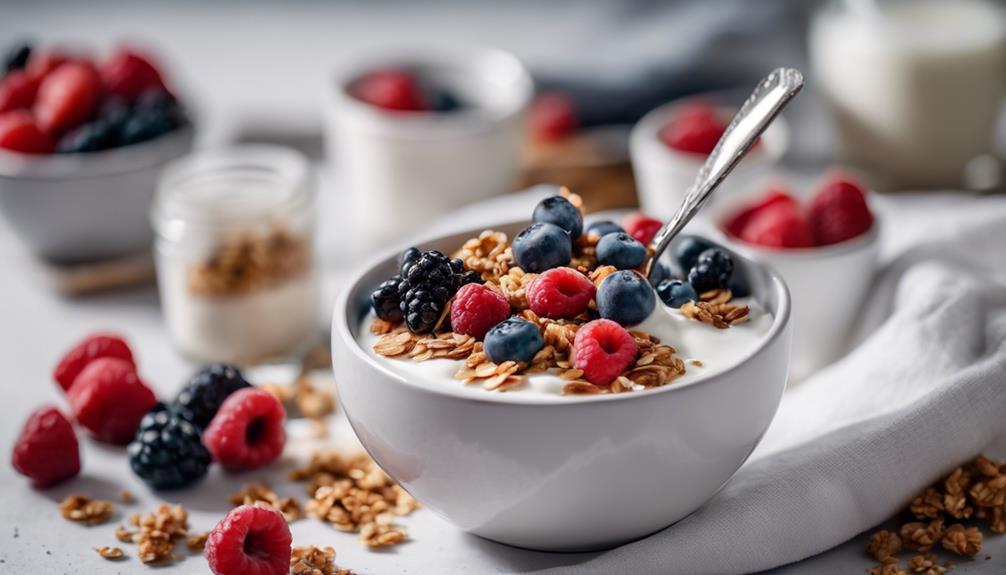
As you wrap up your journey in creating this lectin-free coconut yogurt using the sous vide method, take a moment to reflect on the process and the delicious results you have achieved. By choosing this lectin-free lifestyle, you've not only prioritized health benefits but also embraced the breakfast benefits of incorporating yogurt into your daily routine.
The creamy texture and rich coconut flavor of this yogurt can now be a staple in your morning meals, providing you with a nutritious and satisfying start to your day.
In your quest for a lectin-free lifestyle, it's essential to celebrate each step towards healthier choices. The sous vide method has allowed you to create a yogurt free from harmful lectins while retaining all the probiotic goodness and creamy consistency you love.
As you enjoy your homemade coconut yogurt, savor the knowledge that you're nourishing your body with a wholesome and delicious treat. Keep exploring new ways to enhance your meals with lectin-free options and enjoy the benefits they bring to your well-being.
Frequently Asked Questions
Can I Use Non-Dairy Milk Alternatives in This Recipe?
Yes, you can use non-dairy milk alternatives in this recipe. They offer various nutritional benefits and there are several best brands available. Almond, coconut, and oat milk are popular choices that can enhance the flavor profile.
How Long Does Lectin-Free Coconut Yogurt Last in the Fridge?
When storing lectin-free coconut yogurt in the fridge, it typically lasts around 1-2 weeks. To maximize its shelf life, make sure it's in a sealed container and stored at a consistent temperature. Enjoy the benefits of a lectin-free diet longer with proper storage!
Can I Add Sweeteners or Flavors to the Yogurt?
You can enhance the lectin-free coconut yogurt with various toppings like fresh fruits, nuts, or seeds. These additions not only add flavor but also provide extra health benefits, making your yogurt even more delicious and nutritious.
Is It Possible to Make This Yogurt Without a Sous Vide Machine?
You can make yogurt alternatives without a sous vide machine. Try using a slow cooker or Instant Pot. These cooking methods can help you achieve similar results with ease and convenience. Experiment and enjoy!
Can I Use This Yogurt in Cooking and Baking Recipes?
Yes, you can use this yogurt as a substitute in cooking and baking. It's versatile and works well in various recipes. Experiment with it in both savory and sweet dishes to add a unique flavor twist.
Conclusion
To sum up, making lectin-free coconut yogurt using sous vide is a simple and delicious way to add a healthy boost to your breakfast routine. By following the recipes and techniques outlined in this article, you can create creamy and flavorful yogurt with the perfect texture every time.
Experiment with different flavors and toppings to customize your yogurt to your liking. Enjoy the benefits of homemade yogurt without worrying about lectins.
Start your day right with a nutritious and satisfying breakfast option!






